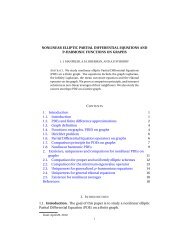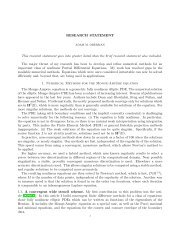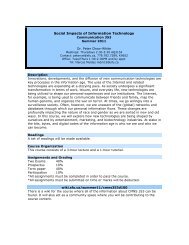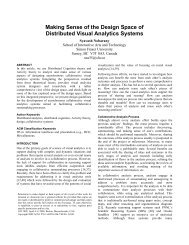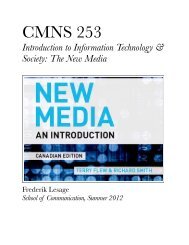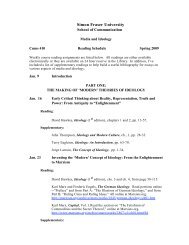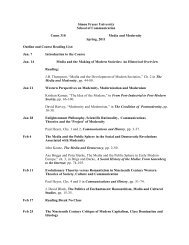CMNS 253 Syllabus - SFU Wiki
CMNS 253 Syllabus - SFU Wiki
CMNS 253 Syllabus - SFU Wiki
You also want an ePaper? Increase the reach of your titles
YUMPU automatically turns print PDFs into web optimized ePapers that Google loves.
1. What has been the significance of creative cities, historically? How do cities today work toremain part of this tradition of creative industry?2. What are the creative industries? How can the dynamics of these industries becharacterized?3. In what ways are knowledge and information different from each other? Why is thisrelevant to understanding both the knowledge economy and creative industries?4. In what ways do policy initiatives undertaken in Canada and different parts of the worldaffect cultural industries?CHAPTER OUTLINEIn this chapter we consider the industrialization of creativity, something that was not initiatedby new digital media—mechanical reproduction of works of art famously preoccupied FrankfurtSchool member Walter Benjamin in the first half of the twentieth century—but the process hasaccelerated, broadened, and deepened with digital media. We begin with an examination of theconcept of creativity itself and especially the question of under what circumstances it canflourish. We next consider the notion of a creative industry and how and why this has become apolicy objective of cities, provinces and states, and countries around the world. The reasons forthe rise of a creative economy, creative cities, and the creative class both as realities and as visionsor ideals, are considered and debated.DISCUSSION QUESTIONS1. What are some examples of historic creative cities? In what ways were they (and are theystill) significant?2. What is meant by the concepts of ‘knowledge push’ and ‘market pull’? What relevance dothese have for cultural industries?3. What new modes of cultural production and consumption in urban centres among youngpeople (18–35 years old) are discussed in this chapter? Why is this shift significant?4. In what ways are ‘knowledge’ and ‘information’ different from each other? Why is thisrelevant in understanding the knowledge economy and creative industries?5. What is the significance of the rise of the service industry sectors in the knowledge-basedeconomy and the ‘culturalization’ of the economy?6. What are the four models of the creative industries proposed by Cunningham and Potts?7. In this chapter, we noted Healy’s (2002: 101) caution against ‘using new economy jargonto give a bullish defence of the arts in economic terms’. Why is this significant?8. What is the ‘creative class’ as discussed in this chapter? In what ways has the concept beenchallenged?9. What are some of the creative industries policy initiatives undertaken in Canada? Howare these seen as affecting cultural industries?



